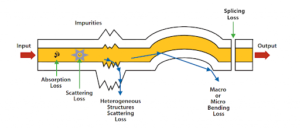Optical fiber loss
Optical fiber is an excellent medium for transmitting optical signals and rarely needs amplification compared to copper cables. High-quality single-mode fiber often has a loss (power loss) of up to 0.1 dB per kilometer.
Power or signal strength (in dB) will always be at the end of the fiber or the final location of the client, because it may degrade during the network connection, and if the effect is too great, the performance will degrade, so understanding and measuring These losses are an important part of optical network installation and testing.
Simply put, loss is the measurement of light that is lost between two fixed points in the fiber. This can happen when optical fibers are spliced, spliced, or sent through additional passive network components. It is often attributed to non-conformance, contamination or poor quality manufactured joints and has long been used to support fusion bonding. However, in reality, the difference between fusion splices and manual splices is marginal.
One of the reasons for fiber loss in the implementation of fiber to home networks (FTTH) is the path of the cable itself. For example, a fiber may travel 10 km from the OLT to the range and have less than 1dB loss, and then triple the loss over the next 100m. Multi-dwelling units (apartments) are an excellent example of complex cable routes and are especially important to protect the bend radius, and run path. The fiber can easily be wrapped or gathered during a tight installation. The bend-sensitive G657A1 core, which is only once 20mm in diameter, will drop by 0.2dB. Twice at 20mm 0.4dB, three times twisted and…
It is true that the connectors are most likely the cause of high drops, but they cannot be considered the only main cause of losses. In fact, we can manage connection losses by setting standards for purchased cables and other connections and training installers to clean equipment. Reducing the number of components in the network also logically reduces the loss, so accuracy in quality and standardization as well as cleanliness are the most basic points to eliminate losses.
Return loss also affects network performance in a different way. This is the amount of signal that is reflected back to the source due to the resistance mismatch – effectively, if this is too high, the laser in the grid may not transmit correctly.
Many systems can tolerate up to -40dB return loss and operate without problems, which is equivalent to 0.01% of the returned energy. However, FTTH has a higher tolerance and cannot exceed -60dB, sometimes more. To achieve these very low loss figures – such as 0.000005 percent or -75dB – optical connectors must have angled ferrules (APCs).
fiber loss
Tips to reduce fiber optic loss
* Minimize tight bends that cause light to refract through fiber cladding. If you must bundle the fiber, keep the radius as large as possible.
Clean interface connections little and often—especially before and after testing—and always use the right tools and consumables.
Avoid any unnecessary pressure on the fiber, especially during installation. Push if possible and do not exceed the maximum tensile load of the cable if you need to pull the cable.
Minimize the number of connections or connections in your network.




